by Jena | Feb 28, 2016 | Brentuximab Vedotin, Campath (alemtuzumab), Infectious Disease, Radiation Therapy, Stem Cell Transplant |
Friday evening, February 26
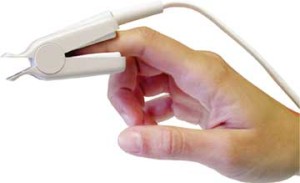 Since Dad was admitted very early Thursday morning, Dad’s oxygen saturation has been continuously monitored with a pulse oximeter on his fingertip. On Friday evening, his saturation level dropped enough to warrant oxygen supplementation. Mom stayed overnight with Dad in his room.
Since Dad was admitted very early Thursday morning, Dad’s oxygen saturation has been continuously monitored with a pulse oximeter on his fingertip. On Friday evening, his saturation level dropped enough to warrant oxygen supplementation. Mom stayed overnight with Dad in his room.
Saturday, February 27
Dad’s temperature was up and down throughout the day. A couple of times Dad experienced a fever that included chills and uncontrollable shivering. He continued to be on oxygen. Dad didn’t have much of an appetite and wouldn’t eat the Moffitt food.
Dr. Ayala, transplant doctor, visited Dad. Mom put me on speakerphone so that I could participate. Dr. Ayala had conferred with Dr. Velez, infectious disease. Dr. Ayala restated what we had heard from Dr. Velez on Friday afternoon. Dr. Ayala wanted Dad to stay another night due to his fever and chills. I inquired about the donor. Dr. Ayala said that the donor was willing to wait for Dad. Hallelujah! Dad is extremely blessed to have such a donor.
I believe the doctors attribute Dad’s bone marrow aplasia from his Campath (alemtuzumab) treatments. Campath is a monoclonal antibody directed against CD52, an antigen (marker) found on both B and T lymphocytes. The drug is used most often to treat chronic lymphocytic leukemia and has been used in the treatment of advanced CTCL. Mom has always questioned if Dad received too many Campath treatments and wondered why Dad wasn’t more closely monitored for bone marrow aplasia.
Dr. Ayala said that Dad is in a difficult position. He has fungal pneumonia because he essentially has no immune system. The only way to get a new immune system is to have a stem cell transplant. Dad must get well in order to receive the stem cell transplant. Dr. Ayala spoke in a way that he was not confident that Dad would be able receive a stem cell transplant in the future.
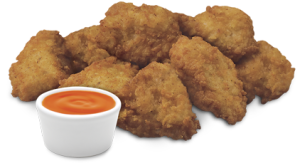 In the afternoon, Daughter and I went to visit Mom and Dad to bring some additional clean clothes for Mom and Dad since Dad was going to remain in the hospital. We also came bearing Chick-fil-A. Nuggets had to be more appealing than the flavorless Moffit food. Upon our arrival, Dad was extremely happy to see us and was slightly overcome with emotion. Perhaps it was the thrill of receiving Chick-fil-A! We could tell that he was quite uncomfortable and not his smiling, happy self. His eyes were dull and fatigued. He seemed physically agitated. Daughter and I were not expecting to see him this way. I sought out Dad’s nurse, Tammy, to give him something to take the edge off.
In the afternoon, Daughter and I went to visit Mom and Dad to bring some additional clean clothes for Mom and Dad since Dad was going to remain in the hospital. We also came bearing Chick-fil-A. Nuggets had to be more appealing than the flavorless Moffit food. Upon our arrival, Dad was extremely happy to see us and was slightly overcome with emotion. Perhaps it was the thrill of receiving Chick-fil-A! We could tell that he was quite uncomfortable and not his smiling, happy self. His eyes were dull and fatigued. He seemed physically agitated. Daughter and I were not expecting to see him this way. I sought out Dad’s nurse, Tammy, to give him something to take the edge off.
Since Dr. Ayala told Dad that he must get out of bed and walk, Mom now had a mission. Later in the evening, she had Dad up and moving around a bit. Dad ate dinner sitting in the chair.
Sunday, February 28
Dad was more lively today. Could it be the Chick-fil-A? He was sitting in the chair. Mom had plans for him to walk “laps” on the third floor of the Blood & Marrow Transplant (BMT) unit. At 12:37 p.m., Dr. Ayala and Karla, transplant physician assistant, came to visit Dad. Dr. Ayala listened to Dad’s lungs and checked his mouth and throat. Dr. Ayala found Dad’s throat to be clear and stated that it was much better. Dad hasn’t experienced any fever today. Dr. Ayala said that Dad looked better overall, especially as compared to yesterday. Dad is to remain at Moffitt tonight since Dr. Ayala wants to be cautious. Dad will be setup to be discharged earlier tomorrow. Dad will continue his antibiotics and anti-fungal medications.
Dr. Ayala did say that this fungal pneumonia was a major setback and that he cannot predict the future. He said that we will see if Dad is able to move forward with the stem cell transplant. Dr. Ayala sounded quite noncommittal. I don’t think Mom heard Dr. Ayala, yesterday, state the he was not confident about Dad’s ability to get a stem cell transplant in the future. Mom seemed surprised by Dr. Ayala’s statement today.
Mom inquired about the slow healing, necrotic egg on Dad’s head that now looks like a big, black mushroom. She wanted to know if it may contain fungus. Dr. Ayala said that it does not, because if it did, Dad would be experiencing pain and soreness at the site. Dr. Ayala doesn’t want to tamper with it as he believe it is healing. He said that the radiation therapy worked marvelously on Dad’s tumors including the egg. The plan is for Dad to see Dr. Baluch, infectious disease, and Dr. Ayala in a couple weeks in the BMT clinic. They will discuss another brentuximab vedotin treatment for Dad.
Before leaving the room, Dr. Ayala told Dad to go for a walk, and Karla said Dad would be receiving a platelet transfusion later today.
by Jena | Feb 26, 2016 | Infectious Disease, Stem Cell Transplant |
Upon entry into Dad’s room, each visitor freshly dresses in a yellow isolation gown, a yellow duck mask, and a pair of bright blue gloves. It is as if each visitor has come to Dad’s costume party wearing the same duck costume.
8:00 a.m.
Mom and I arrived in Dad’s room at Moffitt. Dad said he was feeling better than yesterday. He had already received a platelet transfusion between 5:00 a.m and 6:00 a.m. since his platelet count needed to be at a minimum of 25 for the bronchoavleor lavage procedure today. (He did receive pre-medications this time prior to the transfusion.) Dad had been restricted from food and beverage in preparation for this procedure since midnight. Dad was hungry.
8:40 a.m.
Harmony, transplant physician assistant (PA), came in to check on Dad. She asked if he had any nausea or coughing. He said he hadn’t. Harmony had noticed in Dad’s chart that he had experienced a slight fever overnight. She informed us that Dr. Chan and Dr. Walsh, both from pulmonary, would be coming by this morning, and Dr. Baluch, infectious disease, should be coming by, too. Dr. Ayala and Harmony were to return to see Dad about 10:00 a.m.
9:00 a.m.
Dad was taken for his bronchoalveolar lavage (BAL) procedure.
10:30 a.m.
Dad returned from the BAL to his room very drowsy. The post-op procedure was for the nurse to take his temperate and monitor his heart rate and oxygen for one hour. Dad was to take sips of water at 11:45 a.m. If he did well with the water, he would be allowed to eat lunch.
10:45 a.m.
Dr. Ayala came in with Harmony, physician assistant (PA), and one other. After the BAL, Dr. Ayala felt it was prudent to keep Dad for another 24 hours. Dr. Ayala said that Dad could not begin his stem cell transplant on Sunday as originally planned. This was now his the third delay.
Dr. Ayala said he would talk to Dr. Baluch, infectious disease, about how she was going to address the fungal pneumonia. Dr. Ayala believed they could proceed with the stem cell transplant after Dad has been on an anti-fungal treatment for 1 – 2 weeks. Yet, he needed Dr. Baluch to determine the course of action. The anti-fungal medication may be administered orally or intravenously.
Dr. Ayala said Dad’s skin looked fine and that Dad looked stable. Dr. Ayala said that Dad needs to walk and stay active. Dr. Ayala was hopeful that Dad could get started with the stem cel transplant in the next two weeks. Dr. Ayala said he would communicate with the donor about rescheduling. Mom’s greatest concern is that the donor is available.
I asked Dr. Ayala whether or not Dad should receive another brentuximab vedotin treatment. Dr. Ayala said he will to speak to Dr. Sokol, hematology oncology. We want to keep the CTCL minimized as much as possible while Dad’s transplant continues to be delayed. Dad asked about receiving neupogen shots to keep his white blood cell count up since we believe Dad’s fungal pneumonia is due to his white blood cell count being so low. Dr. Ayala agreed with Dad’s request. Dad will need to continue to have blood support (neupogen shots, blood and platelet transfusions).
Dad should get his central line catheter dressing changed tomorrow, Saturday, before he is discharged.
11:25 a.m.
A man from respiratory therapy came by to check on Dad’s breathing. The therapist was pleased with Dad’s vitals. He let Dad know that Dad could have oxygen if Dad wanted, but the therapist didn’t seem to think Dad would need it.
A dietician came by to check on Dad’s eating. Dad said he has been slowly losing weight. The dietician was going to place a standing order for a Boost milkshake with each of Dad’s meals to increase his caloric intake.
12:55 p.m.
Dr. Paruolo, infectious disease fellow, visited Dad. Dr. Paruolo informed us that Dr. Baluch was out sick and that Dr. Velez was today’s attending infectious disease doctor and would come by this afternoon around 3:00 p.m. or 4:00 p.m.
Dr. Paruolo said that the preliminary results of the BAL would identify the infection as fungal or bacterial. It could take days, even weeks, to obtain a firm diagnosis since fungus grows so slowly. The lab holds all cultures two to six weeks. Dr. Paruolo said that the new nodules on Dad’s latest CT scan were alarming to the team. Dr. Paruolo documented Dad’s travel history to know where he has lived and visited during his lifetime including visiting places for even one week. This was an amusing exercise since Dad was still under the effects of anesthesia. Dad’s brain was in a fog as he was trying to recall all the places he had lived and traveled. His “intoxicated” reactions were comical when I would remind him of places he lived and traveled. I got a good giggle. I think even Dr. Paruolo was slightly entertained.
Dr. Paruolo said that Dad would be scheduled for a 2 week follow up with Dr. Baluch, infectious disease, in the Blood & Marrow Transplant (BMT) clinic. The plan is to send Dad home on (broad-spectrum) anti-fungal medication. As the cultures grow and if the doctor believes a different medication would better target the infection, Dad would be notified and prescribed a different medication. Dad will have another CT Scan to view the impact of the anti-fungal medication.
Mom’s head was spinning from trying to keep track of the numerous visitors, understanding their role and comprehend what each was saying to us.
1:30 p.m.
Dad finally ate lunch. I worked with Dad to select the food and beverages he wanted for dinner tonight and for all three meals tomorrow.
Unfortunately, the food at Moffitt is not the least bit appetizing. Bland and dry are the best adjectives to describe all the options. I know that Moffitt overcooks all the meat and poultry to reduce any risk of a foodborne illness, which is critical for immunosupressed patients. Yet, no one finds shoe leather beef and rubbery, dry chicken delicious. It is not a surprise that patients lose so much weight. Germán, Dad’s nurse technician, shared his view of the unappealing menu and questioned “how hard is it to make good food?” I wonder what Germán eats everyday at work. He probably packs his own scrumptious meals. I certainly would.
2:15 p.m.
I left Mom and Dad at Moffit to take care of Daughter and Son. Mom planned to stay overnight with Dad in his room.
4:30 p.m.
Mom and Dad are still living in Tampa on two suitcases of clothes. Nearly all their clothes are still at their house in the panhandle of Florida. I ran into Target to pick up a new set of pajamas and a robe for Mom. From the sleepwear department, I FaceTimed with Mom to get her input on color and pattern choices for her pajamas and robe.
While Mom was choosing her preferred pajamas over FaceTime, Dr. Velez, Dr. Paruolo and one other from the infectious disease team came into see Dad. Mom flipped around the FaceTime camera so that I could virtually participate. The team of doctors, dressed in their yellow masks and gowns, gave me an enthusiastic wave with their blue, gloved hands. Dr. Velez said that the initial diagnosis from the BAL is pneumocystis pneumonia (PCP), which is an illness caused by the fungus Pneumocystis jirovecii. PCP is one of the most frequent and severe opportunistic infections in people with weakened immune systems. Dr. Velez prescribed Dad two anti-fungal medications.
by Jena | Feb 25, 2016 | Infectious Disease, Stem Cell Transplant |
Yesterday, after Dad got home from Moffitt, Mom called me at 4:30 p.m. to say that Dad had a fever, 100.4, and was experiencing some chills. Dad spoke to the Moffitt nurse via phone. The nurse told Dad to take Benadryl since she believed his fever was a reaction to his platelet transfusion. Dad traditionally takes pre-medications to prevent reactions, but for some reason, Dad didn’t take any prior to his platelet transfusion yesterday.
Yesterday evening, I spoke to Mom and Dad at 6:00 p.m. asking how Dad was feeling after taking the Benadryl. He indicated that he was improving.
On the way home from dropping the kids off at school this morning, Thursday, I called to check on Dad. Unbeknownst to me, I learned that Dad had checked into the hospital at Moffitt at 1:30 a.m.
Last night, Dad had taken another dose of Benadryl at 10:00 p.m. Dad had then taken his temperature multiple times at 11:30 p.m. Results were 98.4, 100.2 and 101.2. They had been concerned and had called the Moffitt night nurse again. Dad was instructed to come into Moffitt in the middle of the night.
I wasn’t happy that Mom and Dad sneaked off, in the middle of the night, to Moffit without my knowledge.
Upon arrival to Moffitt last night, Dad had numerous vials of blood taken and a chest X-ray, using a portable machine. Around 4:30 a.m., he has his nose swabbed. I arrived around 10:00 a.m. Shortly thereafter, Dr. Ayala, transplant doctor, came in with four others. They were dressed in their yellow, disposable gowns, bright blue gloves, and yellow, duck masks. Dr. Ayala gave Dad a brief physical exam. He wanted to know if Dad had been experiencing anything more than a fever. Dad said he hadn’t. Dr. Ayala also checked Dad’s mouth. No sign of redness. Dr. Ayala wanted a better look at Dad’s lungs since the portable X-ray was a bit cloudy and was showing a couple of patches. Dr. Ayala ordered another (better) X-ray. As the team of doctors were leaving Dad’s room, Dr. Ayala teased Dad about showing up too early for his Sunday, inpatient check-in for his stem cell transplant and said “…no more fun and games.”
The better X-ray showed spots in Dad’s right lung. Dr. Baluch, infectious disease, then ordered a CT scan of Dad’s lungs. Later, Harmony, physician assistant (PA), came by with the initial results of the CT scan. Dr. Baluch is concerned about two spots, which look like fungal pneumonia. Harmony pulled up Dad’s CT scans from February 11th and today. By comparing the two, it was evident that the two spots are new on today’s CT scan. Harmony said that fungal pneumonia is uncommon and mostly seen in patients who are neutropenic and could take weeks to months to eliminate.

Bronchoalveolar lavage (BAL)
Dr. Chan, pulmonary, came by to learn about Dad’s history and current symptoms. She described a bronchoalveolar lavage (BAL), a diagnostic procedure, where fluid is introduced into the terminal bronchioles and then recollected for analysis. BAL aims to establish a diagnosis to find out if an infection is present. Later, Dr. Chan consulted with Dr. Walsh, also in pulmonary. The plan is for Dad to stay at Moffitt tonight and to do the BAL in the morning.
We are still waiting to meet with Dr. Baluch, infectious disease, in order to get her view of how the fungal pneumonia impacts Dad’s stem cell transplant schedule. We know that the probability is high that Dad will not start his stem cell transplant preparations as an inpatient on Sunday as we were hoping. Mom is extremely disappointed.
As I was typing this post, Mom was assisting Dad with his shower. Mom stepped out of the bathroom, momentarily, to get Dad a fresh pair of pajamas. Then, we heard what sounded like Dad falling in the shower. Fortunately, he caught himself by pulling on the shower alarm. In an instant, Dad’s nurse, technician, and another gentleman ran to Dad’s room. Thank goodness it was a false alarm! I reminded Dad that he is at severe risk of dying from a brain bleed if he were to fall and hit his head. His platelets are so low that he has little ability to clot.
Dad, no more fun & games…especially in the shower.
by Jena | Feb 24, 2016 | Stem Cell Transplant |
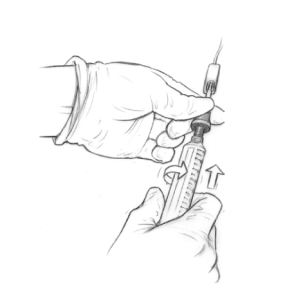 This past week has been mostly filled with trips to Moffitt for Dad to get his central line catheter flushed daily and to receive blood support.
This past week has been mostly filled with trips to Moffitt for Dad to get his central line catheter flushed daily and to receive blood support.
Saturday, February 20: Dad had to go to the main campus of the Moffitt Cancer Center since the Moffitt Cancer Center at International Plaza (MIP) is only open on weekdays. Dad’s dressing for his central line catheter was changed. His line was flushed.
Sunday, February 21: Back at the main campus of Moffitt again, Dad had his central line catheter flushed.
Monday, February 22: At Moffit Cancer Center at International Plaza (MIP), Dad had his central line catheter flushed and a blood draw to check his counts. All counts (white blood cells, platelets and hemoglobin) came back low.
Tuesday, February 23: Dad returned to MIP for his daily central line catheter flush. He received two bags of blood via transfusion to boost his hemoglobin level.
Wednesday, February 24: Dad went to the main campus of the Moffitt Cancer Center. He met with Denise, the transplant coordinator, and she shared good news. The 19 year old donor was able to reschedule so that Dad can be admitted this Sunday, February 28th to begin his stem cell transplant process. We are very happy! Dad also had his daily central line catheter flushed and received a platelet transfusion.
by Jena | Feb 19, 2016 | Stem Cell Transplant |
At 8:00 a.m., Dad had his blood counts checked to determine whether or not he needed another platelet transfusion to get his platelet count above 50 (50,000/mcL of blood). 50 is required for the medical procedure to place Dad’s new central line catheter. Dad’s platelet count came back at 64. Thus, no need for a platelet transfusion this morning. It was important for Dad to have enough platelets in order to clot, as needed for the procedure.
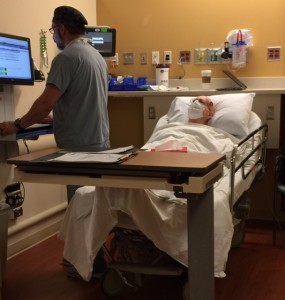
Dad getting ready for his central line catheter procedure.
At 10:00 a.m., Dad was prepped for his central line catheter procedure in the outpatient surgery department. Two small incisions were made in Dad’s upper right chest. One incision was made near his neck, and the second was made a little lower to insert the catheter into the proper place. The catheter was “tunneled” under his skin. He received some stitches in his chest close to the catheter exit. These stitches will be removed in 21 days when his skin has healed around the catheter. The procedure took about 45 minutes with an additional 30 minutes for recovery.
When Mom and I went to see Dad in recovery, he was happily drinking an orange Gatorade. He hadn’t been able to eat nor drink since midnight the day before. We discussed plans to eat lunch. We were determined not to eat in the Moffitt cafeteria since Dad, along with Mom and I, would be eating this food for the next month. Dad was craving pizza. Mom was adamant that Dad not dine in a restaurant for fear of picking up an illness. Thus, we agreed upon take-out. Dad seems to enjoy Little Caesar’s HOT-N-READY DEEP! DEEP! Dish pepperoni pizza. I am not a pizza fan, but I want Dad to enjoy his last few meals “outside” of Moffitt. It should be all about what he wants to eat.
At 12:30 p.m., we returned to the Blood & Marrow Treatment (BMT) Center to learn about post-insertion care. Dad may have some discomfort in his shoulder and chest area over the next few days. The physician’s assistant (PA) recommended 1,000 mg of Tylenol to relieve any discomfort. They provided ice packs for Dad to apply to the catheter site 20 minutes at a time, every hour, as needed for the first 24 – 48 hours. Dad is to expect a small amount of blood and bruising around the exit site. He cannot shower for 48 hours.
We did find it odd that the BMT nurse had to remove Dad’s PICC line since the surgery team did not remove it during Dad’s central line catheter procedure. We had been under the impression that it would occur during the surgery. This was even discussed with the doctor 20 minutes prior to the procedure.
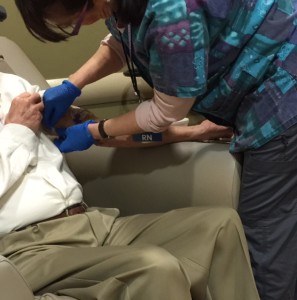
Nurse removing Dad’s PICC line.
The nurse indicated that removing a PICC line was rather commonplace in the BMT treatment center. The nurse removed the dressing on and around the PICC and pulled the line right out of Dad’s left arm. The amount of line that came out of Dad’s arm was incredible. How could all that line be inside of him? The nurse felt bad since a couple drops of blood fell onto his shirt. She worked hard to remove the blood stain.
As we were getting our final questions answered, Dad happened to mention to the nurse that he has had a slight sore throat the past three days. Mom and I were unaware of this slight sore throat. Well, that sounded the alarms! The nurse went to speak to the PA. Dad had his nose and throat swabbed to check for infection. The PA looked at Dad’s throat and said it looked like strep throat. The PA consulted with two other PAs, who also examined Dad’s throat, and agreed that it looked like strep. The PAs were puzzled since Dad’s throat was only slightly sore. They ran a rapid-strep test, which came back negative. For now, the initial diagnosis is rhino-virus (the common cold) and potentially something fungal. Dad was prescribed two medications. The swab results won’t be back from the lab for a few days to provide a more definitive diagnosis.
The PA consulted with Dr. Ayala. The bad news is that Dr. Ayala has postponed Dad’s stem cell transplant. He won’t be admitted on Sunday. This is very upsetting for Mom. Dad is now scheduled to see Dr. Ayala on Wednesday, February 24th.
We are on the stem cell transplant roller coaster.
 Since Dad was admitted very early Thursday morning, Dad’s oxygen saturation has been continuously monitored with a pulse oximeter on his fingertip. On Friday evening, his saturation level dropped enough to warrant oxygen supplementation. Mom stayed overnight with Dad in his room.
Since Dad was admitted very early Thursday morning, Dad’s oxygen saturation has been continuously monitored with a pulse oximeter on his fingertip. On Friday evening, his saturation level dropped enough to warrant oxygen supplementation. Mom stayed overnight with Dad in his room. In the afternoon, Daughter and I went to visit Mom and Dad to bring some additional clean clothes for Mom and Dad since Dad was going to remain in the hospital. We also came bearing Chick-fil-A. Nuggets had to be more appealing than the flavorless Moffit food. Upon our arrival, Dad was extremely happy to see us and was slightly overcome with emotion. Perhaps it was the thrill of receiving Chick-fil-A! We could tell that he was quite uncomfortable and not his smiling, happy self. His eyes were dull and fatigued. He seemed physically agitated. Daughter and I were not expecting to see him this way. I sought out Dad’s nurse, Tammy, to give him something to take the edge off.
In the afternoon, Daughter and I went to visit Mom and Dad to bring some additional clean clothes for Mom and Dad since Dad was going to remain in the hospital. We also came bearing Chick-fil-A. Nuggets had to be more appealing than the flavorless Moffit food. Upon our arrival, Dad was extremely happy to see us and was slightly overcome with emotion. Perhaps it was the thrill of receiving Chick-fil-A! We could tell that he was quite uncomfortable and not his smiling, happy self. His eyes were dull and fatigued. He seemed physically agitated. Daughter and I were not expecting to see him this way. I sought out Dad’s nurse, Tammy, to give him something to take the edge off.


 This past week has been mostly filled with trips to Moffitt for Dad to get his central line catheter flushed daily and to receive blood support.
This past week has been mostly filled with trips to Moffitt for Dad to get his central line catheter flushed daily and to receive blood support.

Recent Comments